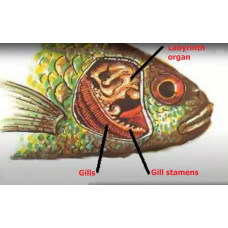The labyrinth, an auxiliary organ of respiration, is a chamber in the region of the first gill arch. The folded walls of the chamber are penetrated by a dense network of capillaries, in which the blood is enriched with air oxygen. It is present in the perch-crawler and many tropical fish.
The organ is a folded and cellular adventitious respiratory apparatus lying in a special supra-gill cavity (protrusion of the upper gill cavity), which communicates with the gill cavity. It is formed by a system of several thin bony plates (extensions of the gill arch), coming from the pharyngeal bones and the nearest bones of the skull and penetrated by blood vessels. The plates of the labyrinthine organ are lined with mucous membrane with a strongly developed network of blood vessels (capillaries); it receives air, which fish capture with their mouths. Venous blood enters the labyrinthine apparatus through the bringing gill vessel; oxidized, the blood is directed from it to the dorsal aorta and spread throughout the body.
In fry, the labyrinth organ is formed only 2-5 weeks after hatching, and they, unlike adult fish, need oxygenated water.
Contrary to the popular opinion in the past that the additional respiratory organ (labyrinth apparatus) allegedly contains a reserve of water to moisten the gills, this cavity appears to be filled with air and serves as an organ of air breathing. According to some observations labyrinth fish suffocate in the water, if they can not capture air on its surface.
Thus, the labyrinth apparatus allows these fish to additionally breathe atmospheric oxygen, to exist in small amounts of water, in conditions of lack of oxygen in the water and poor water quality, to be out of water for a long time, but can not completely replace the gills.
Labyrinth fish include: cockerels (fighting fish, betta), all gourami, ctenopoma, macropods, swordfish, lalius and others.
Labyrinth
Tags: labyrinth

